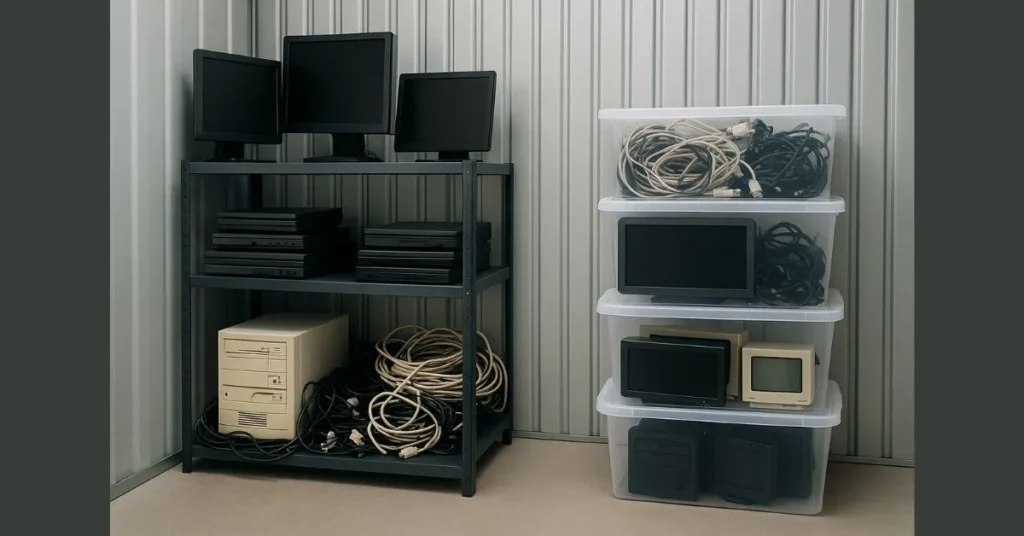Outdated technology equipment piles up easily at the house and the office. Laptops, monitors, and wires sit unused but still carry personal or professional value. Some people hoard equipment for back-up needs, and others wish to re-purpose them down the line. The problem is that stowing equipment inside closets or storage spaces can take up too much required space and even become dangerous. Accessing a self storage unit can be a convenient solution, giving people additional space at home while their old electronics are secured and organized neatly.
Historical Note: Technology replacement at a brisk pace isn’t a new process. Personal computers of the 1980s like the IBM PC and Apple II gained pace and were succeeded within a few years by swifter and more capable versions. Houses and businesses used to retain older machines because they’d invested significant amounts of money in them, although they didn’t quite meet modern requirements. This process of preserving obsolete machines highlights the need for storage solutions today because people still endeavor balancing investment, sentimental worth, and everyday use.
Contents
Why Old Gear Piles Up
Many households and businesses hold onto old technology long after it stops being used. People save old laptops, phones, and monitors in case they might need them again. Others keep them because of the money spent on the original purchase. There is also the worry that important files or personal data may still be stored on the devices, so they do not want to throw them away. Over time, closets, garages, and office shelves fill with these items, creating clutter and sometimes even safety hazards.
- Devices are kept for sentimental or backup reasons
- Concerns about personal data being lost or exposed
- Value attached to the money originally spent
The problem is that most of these items never get reused. Instead, they gather dust, take up space, and become harder to sort through as years go by. Families often forget what devices still work, and businesses may overlook equipment that could have been recycled responsibly. Old batteries and cords left in piles can even create risks such as leaks or fire hazards. By understanding why this buildup happens, people can take steps to manage it more effectively. Finding proper places to store these devices until they are needed again or prepared for recycling can help clear out living and working spaces.
Risks of Home Storage
- Old batteries can leak and damage other items
- Dust and humidity can harm sensitive electronics
- Stacks of devices create fire and safety risks
- Misplaced items lead to wasted time and stress
Observation: A family once stored old phones, game consoles, and chargers in a cardboard box in their garage. Years later, when they opened it, the batteries had leaked, damaging not only the devices but also nearby books and tools. What started as a small pile became an unexpected mess.
Storing old tech gear at home often feels convenient, but it creates hidden dangers over time. Electronics are sensitive to changes in temperature and moisture. Leaving them in basements, garages, or closets can cause parts to corrode or break down. Stacks of items also increase the chance of accidents, whether from tripping or electrical problems. In addition, forgotten devices take up valuable space that could be better used. Understanding these risks helps people decide whether home storage is truly the right choice or if safer options make more sense.
Benefits of Self Storage
Using a self storage unit gives old tech gear a safe, organized home. Climate control protects laptops, cameras, and hard drives from heat and humidity that cause corrosion and data loss. Secured access, cameras, and individual locks reduce the risk of theft. Shelving and labeled bins turn a packed closet into a clear system where you can find cables and parts fast. Month to month plans scale up or down as your needs change, which is useful during office upgrades or moves. Examples like wine storage and climate controlled units in Anaheim, CA show how steady temperature and humidity protect sensitive items; the same approach works well for electronics. A separate space also keeps batteries and power supplies away from living areas, lowering fire risk and clutter at home. When everything has a place, you spend less time searching and more time using what works.
Research: Common electronics guidance recommends stable temperatures around 60–75°F and relative humidity near 40–55 percent. Manufacturers often suggest storing lithium ion batteries at roughly half charge and checking them every few months. Anti static bags help prevent static damage, while rigid bins reduce crushing. These practices align with climate controlled storage to limit moisture swings and extend device life.
Organizing Tech Safely
Clear bins versus cardboard: clear bins resist moisture and make contents visible, while cardboard is cheaper but weak in damp spaces. Shelves versus floor stacking: shelves improve airflow and access; stacking risks crush damage and tripping. Anti static bags versus bubble wrap: anti static protects boards and memory; bubble wrap cushions but can hold static. Inventory app versus spreadsheet: apps scan barcodes and add photos; spreadsheets are simple and flexible but easier to misplace.
Case study: A small design studio boxed retired laptops and drives by project, added labels with dates, and logged serial numbers with photos in an app. Retrieval time dropped from hours to minutes, and they safely recycled extras after a quarterly review.
Start by sorting devices into keep, repair, and recycle groups. Remove batteries from items not in use, store loose cells in battery cases, and place boards in anti static bags. Coil cables with ties and label both ends. Use a simple shelf map so anyone can find parts quickly. Review inventory each quarter to test drives, charge batteries to mid level, and retire what no longer works.
Recycling and Reuse
An electronics repair shop described the ways they managed mountains of obsolete electronics through recycling and storage. They stored operational but unutilized phones and laptops in a small climate controlled storage unit. Electronics were labeled, charged up mid level, and stowed away in protective cases. When a customer needed an affordable replacement part, they pulled it from storage instead of having brand-new ones shipped in. Through the decades, the practice saved them dollars, decreased mess in their workspace, and gave customers quick solutions. The shop also arranged through a recycling firm for electronics beyond repair so nothing went into a landfill unnecessarily.
Nearly 50 million tons of e-waste are generated worldwide each year, and fewer than 20 percent are disposed of properly through recycling.
Experts further remark that recycling and proper storage go hand in hand. When electronics receive proper storage, households and small businesses can distinguish what can be responsibly recycled, sold, or reused. Small businesses and households’ testimonials cite the reduction of waste and stress through preparation. A parent cited that proper storage of an old laptop enabled their child to use it for school when their latest one conked out. These real-world anecdotes describe how preparation is worth it and makes recycling and reuse an environmental choice but a pragmatic one.
Final Thoughts
Managing old tech gear with self storage units is about more than freeing space. It is about safety, sustainability, and smart planning. By keeping devices organized and protected, you gain peace of mind while preparing for future use or recycling. Self storage units make managing old tech gear a smart and simple decision.

